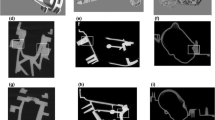Abstract
This work aims to characterize different objects on a scene by means of some of their morphological properties. The leading application consists in the analysis of ductile cast iron specimen pictures, in order to provide a quantitative evaluation of the graphite nodules shape; to this aim the material specimen pictures are binarized. Such a binarization process can be formulated as an optimal segmentation problem. The search for the optimal solution is solved efficiently by training a neural network on a suitable set of binary templates. A robust procedure is obtained, amenable for parallel or hardware implementation, so that real-time applications can be effectively dealt with. The method was developed as the core of an expert system aimed at the unsupervised analysis of ductile cast iron mechanical properties that are influenced by the microstructure and the peculiar morphology of graphite elements.









Similar content being viewed by others
References
Mumford D, Shah J (1989) Optimal approximations by piecewise smooth functions and associated variational problems. Commun Pure Appl Math XLII(4):577–685
Dal Maso G, Morel JM, Solimini S (1992) A variational method in image segmentation: existence and approximation results. Acta Matematica 168:89–151
Osher S, Sethian JA (1988) Fronts propagating with curvature dependent speed: algorithms based on the Hamilton–Jacobi formulation. J Comput Phys 79(12):12–49
Sethian JA (1999) Level set methods and fast marching methods: evolving interfaces in computational geometry, fluid mechanics, computer vision, and material science. Cambridge monograph on applied and computational mathematics. Cambridge University Press, Cambridge
Aubert G, Vese LA (1997) A variational method in image recovery. SIAM J Numer Anal 34(5):1948–1979
Chan TF, Vese LA (2001) Active contours without edges. IEEE Trans Image Process 10(2):266–277
Perona P, Malik J (1990) Scale-space and edge detection using anisotropic diffusion. IEEE Trans Pattern Anal Mach Intell 12(7):629–639
Alvarez L, Lions PL, Morel JM (1992) Image selective smoothing and edge detection by nonlinear diffusion. SIAM J Numer Anal 29:845–866
Weickert J, Romeny BMTH, Viergever MA (1998) Efficient and reliable schemes for nonlinear diffusion filtering. IEEE Trans Image Process 7(3):398–410
Cheng HD, Jiang XH, Sun Y, Wang J (2001) Color image segmentation: advances and prospects. Pattern Recognit 34:2259–2281
Imasogie BI, Wendt U (2004) Characterization of graphite particle shape in spheroidal graphite iron using a computer based image analyzer. J Miner Mater Charact Eng 3(1):1–12
Sund T, Eilertsen K (2003) An algorithm for fast adaptive image binarization with applications in radiotherapy imaging. IEEE Trans Med Imaging 22:1–8
Landabaso JL, Li-QunXu, Pardas M (2004) Robust tracking and object classification towards automated video surveillance. Lecture notes in computer science. Springer, Berlin Heidelberg New York, p 3212
Stringa E (2000) Morphological change detection algorithms for surveillance applications. In: The 11th British machine vision conference, University of Bristol, 11–14 September
Sauvola J, Pietikäinen M (2000) Adaptive document image binarization. Pattern Recognit 33(2):225–236
Ying Liu, Srihari SN (1997) Document image binarization based on texture features. IEEE Trans PAMI 19(5):540–544
Greno GL, Otegui JL, Boeri RE (1999) Mechanism of fatigue crack growth in austempered ductile iron. Int J Fatigue 21:35–43
Labrecque C, Gagne M (1998) Review ductile iron: fifty years of continuous development. Can Metall Q 37(5):343–378
Ward RG (1962) An introduction to the physical chemistry of iron and steel making. Arnold, London
ASTM Designation (1985) A445-63T, part 2; ASTM Designation A247-67, annual book
Bhandarkar SM, Koh J, Suk M (1996) A hierarchical neural network and its application to image segmentation. Math Comput Simul 41:337–355
Special issue on neural networks applications to image processing (1998) IEEE Trans Image Process 7(8)
Lin-Chen W, Der SZ, Nasrabadi NM (1998) Automatic target recognition using a feature-decomposition and data-decomposition modular neural network. IEEE Trans Image Process 7(8):1113–1121
Zhigang Z, Shiqiang Y, Guangyou X, Xueyin L, Dingij S (1998), Fast road classification and orientation estimation using omni-view images and neural networks. IEEE Trans Image Process 7(8):1182–1197
Shen D, Ip HHS (1997) A Hopfield neural network for adaptive image segmentation: an active surface paradigm. Pattern Recognit Lett 18:37–48
Ma L, Staunton RC (2005), Integration of multiresolution image segmentation and neural networks for object depth recovery. Pattern Recognit 38:985–996
Restrepo HF, Hoffmann R, Perez-Uribe A, Yeuscher C, Sanchez E (2000) A networked FPGA-based hardware implementation of a neural network application. IEEE symposium on field-programmable custom computing machines, pp 337–338
Moerland PD, Fiesler E (1997) Neural network adaptations to hardware implementations. In: Handbook of Neural Computation
Negnevitsky M (2002) Artificial intelligence. Addison-Wesley, Reading
Combettes PL, Pesquet JC (2004) Image restoration subject to a total variation constraint. IEEE Trans Image Process 13(9):1213–1222
Pang CCC, Lam WWL, Yung NHC (2004) A novel method for resolving vehicle occlusion in a monocular traffic-image sequence. IEEE Trans Intell Transp Syst 5(3):129–141
Soatto S, Yezzi A, Duci A (2003) Region matching and tracking under deformations or occlusions, in geometric level set methods in imaging, vision and graphics. In: Osher S, Paragios N (eds). Springer, Berlin Heidelberg New York
Author information
Authors and Affiliations
Corresponding author
Rights and permissions
About this article
Cite this article
De Santis, A., Di Bartolomeo, O., Iacoviello, D. et al. Optimal binarization of images by neural networks for morphological analysis of ductile cast iron. Pattern Anal Applic 10, 125–133 (2007). https://doi.org/10.1007/s10044-006-0052-8
Received:
Accepted:
Published:
Issue Date:
DOI: https://doi.org/10.1007/s10044-006-0052-8




